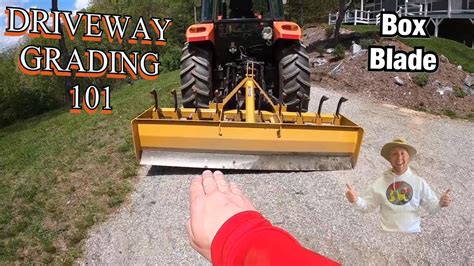How to Grade a Driveway: No Tractor Needed!
A perfectly graded driveway enhances curb appeal, improves drainage, and ensures a smoother, safer ride. While heavy machinery like tractors can certainly make the job easier, grading your driveway without one is entirely achievable with the right tools, techniques, and a little elbow grease. This guide provides a comprehensive, step-by-step process to successfully grade your driveway without needing a tractor.
Assessing Your Driveway and Gathering Tools
Before you begin, a thorough assessment is crucial. This includes:
- Identifying the problem areas: Note low spots where water pools, uneven sections causing bumps, and areas with excessive slopes. Take photos to aid in planning.
- Determining the material: Is your driveway gravel, asphalt, or concrete? The grading process will differ slightly depending on the material.
- Measuring the driveway's dimensions: This will help you estimate the amount of material needed, if any.
Essential Tools:
- Shovel: A sturdy shovel is your primary tool for moving material. A square-ended shovel works best for leveling.
- Rake: A landscape rake is excellent for smoothing out smaller irregularities and spreading materials evenly.
- Level: A long level (at least 4 feet) ensures accurate grading. A laser level offers even greater precision, but isn't essential.
- Wheelbarrow: To efficiently transport material.
- Measuring Tape: For accurate measurements and planning.
- Grading Stakes and String: These help establish a consistent grade across the driveway.
- Tamp (optional): For compacting gravel driveways.
- Garden Hose: Useful for checking drainage after grading.
Establishing the Correct Grade
Proper grading is essential for effective water drainage. The driveway should slope gently away from your house to prevent water accumulation near the foundation. A general guideline is a slope of 1/4 inch per foot.
How to Determine the Proper Slope (1/4 inch per foot):
- Measure: Measure the length of your driveway.
- Calculate the drop: For every foot of driveway length, the drop should be 1/4 inch. Multiply the driveway length (in feet) by 0.25 inches to find the total drop needed.
- Mark the points: Use your level and stakes to mark the high and low points of your driveway, ensuring the correct slope.
Step-by-Step Grading Process
- Clear the Driveway: Remove any debris, weeds, or obstacles.
- Establish Grade Lines: Using your stakes and string, create lines along the edges of the driveway, representing your desired grade.
- Begin Moving Material: Using your shovel, start moving material from high points to low points. Work in small sections, frequently checking your work with the level.
- Smooth the Surface: Use the rake to even out the surface, paying attention to details and ensuring a consistent grade.
- Check Drainage: Carefully pour water along the driveway surface to check if the water flows freely away from the house. Adjust the grade as needed.
- Compact (if applicable): For gravel driveways, use a tamp to compact the material, ensuring a solid and stable surface.
- Final Inspection: Walk the entire driveway, carefully checking for any uneven spots or areas needing further adjustment.
Addressing Specific Issues
How to Fix Low Spots in a Driveway?
Low spots are commonly addressed by adding more gravel or filling material. Spread the added material evenly and compact if necessary.
How to Fix Uneven Driveway Sections?
Uneven sections require removing excess material from high points and filling low spots. Repeatedly check with the level to ensure consistency.
How Often Should I Grade My Driveway?
The frequency of grading depends on factors like weather conditions, material type, and traffic. Gravel driveways may need grading more often than concrete. Annual grading is often sufficient, but more frequent checks and minor adjustments might be needed.
What Material Should I Use to Fill Low Spots?
The choice of fill material depends on your existing driveway. For gravel driveways, use additional gravel of similar size and type. For asphalt or concrete, you might need a patching compound designed for the material.
This detailed guide provides you with the knowledge and steps to grade your driveway effectively without relying on heavy machinery. Remember patience and precision are key to achieving a perfect result. With careful planning and execution, you'll enjoy a smoother, safer, and more aesthetically pleasing driveway for years to come.

